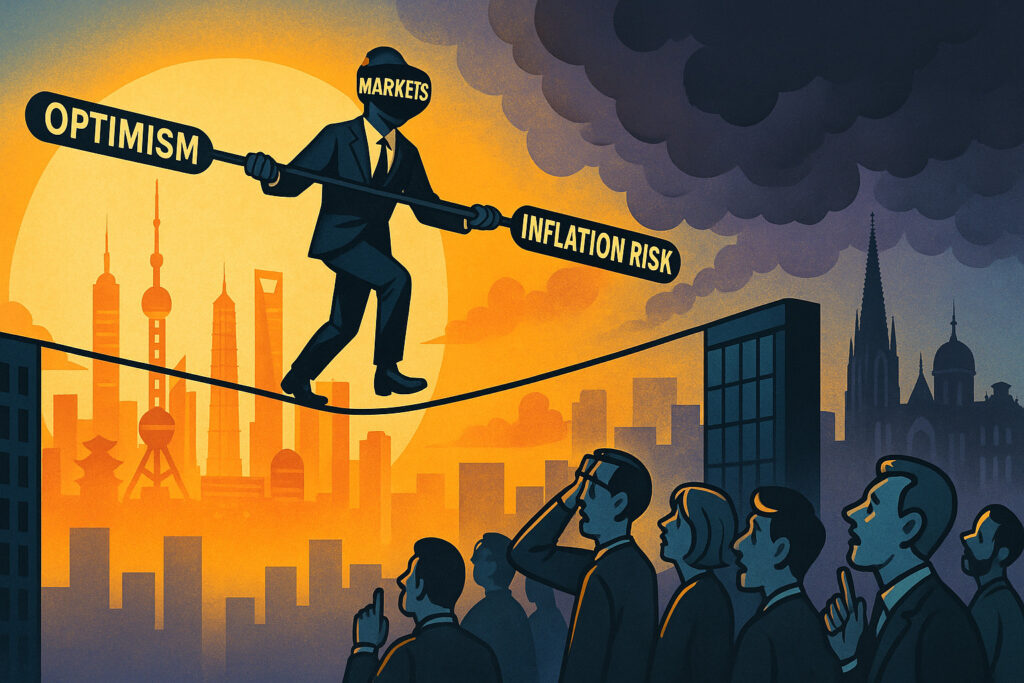Introduction
On 1 September 2025, global markets began the new month with a mixture of optimism and caution. The previous weeks had been marked by record‑setting highs in U.S. equities, driven by enthusiasm for artificial intelligence and hopes of forthcoming Federal Reserve rate cuts. Yet fresh political turmoil in Indonesia and persistent inflation risks tempered investor confidence. While Chinese equities extended their rally, U.S. markets were largely muted due to the Labor Day holiday, and European bourses traded cautiously as investors awaited critical economic data.
This session highlights how local shocks and global policy uncertainty intersect. With the Federal Reserve’s credibility still under scrutiny and major inflation and employment reports looming, investors entered September balancing enthusiasm for growth themes with vigilance over macro and geopolitical risks.
Body
U.S. Markets Quiet on Labor Day Closure
American stock markets were closed on 1 September in observance of Labor Day, leaving futures to set the tone. Futures on the S&P 500 and Dow Jones Industrial Average showed modest gains in thin trading, reflecting continued optimism over the prospect of a September rate cut. The Nasdaq futures also leaned slightly positive, though investors remained cautious given recent volatility in tech shares.
The quiet trading day in the U.S. underscored the market’s pause ahead of crucial data: the August jobs report and the PCE inflation index. These indicators are expected to determine the Federal Reserve’s next move at the September policy meeting.
China Extends Its AI-Driven Equity Rally
China’s stock markets stood out once again, powering higher on the back of strong domestic capital inflows. The CSI 300 index climbed further, building on a 14% monthly gain in August, making it one of the best-performing global indices of 2025. Investors, facing limited returns in bonds and a cooling property market, continued to redirect capital into equities, particularly technology and consumer sectors.
Chinese tech giants led the rally. Alibaba surged nearly 19% in August, buoyed by strong growth in cloud and AI segments. This performance reflected not only optimism about Chinese innovation but also the broader global enthusiasm for artificial intelligence as a transformative driver of earnings.
Indonesia Protests Shake Southeast Asian Markets
While China powered ahead, other parts of Asia were unsettled by political turmoil. In Indonesia, violent protests escalated, leading to casualties and sparking concerns over stability in Southeast Asia’s largest economy. The Jakarta Composite Index tumbled more than 3%, and the Indonesian rupiah fell by nearly 1%, prompting Bank Indonesia to intervene in foreign exchange markets.
These developments remind investors of the fragility of emerging markets when domestic politics spill into the streets. With global investors already nervous, such unrest added another layer of caution to portfolio allocations.
European Markets Show Caution Amid Inflation Pressure
In Europe, the Stoxx 600 index closed slightly higher, up 0.1%, though gains were tempered by sector-specific weaknesses. Travel and leisure names, including airlines, came under pressure following weaker demand forecasts and broader economic uncertainty. European bond yields continued to rise, especially in Germany and the UK, reflecting heavy government borrowing and inflation concerns.
The divergence between Europe’s cautious optimism and Asia’s China-led rally highlights the uneven global investment landscape at the start of September.
Commodities: Gold at Four-Month High, Oil Softens
Commodities reflected the cautious mood. Gold surged above $3,550 per ounce, hitting a four-month high, as investors sought safety amid global volatility and lingering policy uncertainty. The fact that gold recently overtook U.S. Treasuries as the leading global reserve asset underscores its renewed role in an era of fiscal strain and political unpredictability.
In contrast, oil prices slipped slightly below $78 per barrel, pressured by expectations of a supply glut. While geopolitical risks, including continued conflict in Ukraine, limited the downside, concerns over weakening global demand weighed on crude markets.
Currency Markets: Balancing Policy and Politics
The U.S. dollar index remained steady near 104, balancing rate-cut optimism with concerns about political interference in central bank independence. The euro edged lower on eurozone growth concerns, while the yen stayed weak above 149 per dollar as Japan’s long-term bond yields rose in line with global peers. Among emerging market currencies, the Indian rupee remained under pressure, reflecting investor concerns over newly imposed tariffs and foreign institutional investor outflows.
Investor Sentiment: Fragile but Hopeful
Investor psychology at the start of September reflects a fragile but persistent optimism. On one hand, equities, particularly in China, continue to benefit from AI-driven enthusiasm and liquidity support. On the other, the combination of elevated inflation, bond yield volatility, and geopolitical unrest acts as a brake on broader risk-taking.
Investor flows indicate cautious reallocation: U.S. small-cap funds attracted inflows, reflecting speculative optimism in a rate-cut environment, while bond and money market funds saw renewed interest as hedges against macro risk. This duality underscores a market navigating between growth aspirations and defensive positioning.
Conclusion
1 September 2025 closed with global markets moving in different directions. Chinese equities surged, pushing the CSI 300 further into record territory, while U.S. markets remained quiet during the holiday break. European markets edged higher, though inflation and fiscal concerns limited gains. Meanwhile, Indonesia’s unrest weighed heavily on local equities and the rupiah, reminding investors of the persistent risks in emerging markets.
Key questions going forward:
- Will the U.S. nonfarm payrolls report confirm labor market softness, cementing the path toward September rate cuts?
- Can China’s equity rally sustain momentum in the face of profit-taking and geopolitical risks?
- How will European bond pressures affect investor allocations if inflation remains stubbornly elevated?
- Will geopolitical tensions in Southeast Asia and Ukraine trigger broader contagion in global risk sentiment?
The opening day of September exemplified the balancing act that now defines markets: a tug-of-war between growth-fueled optimism and caution rooted in policy and political uncertainties. Investors step into the new month hopeful—but decidedly vigilant.
